Gridded Livestock of the World 2.01
Type of resources
Available actions
Topics
Keywords
Contact for the resource
Provided by
Years
Representation types
-
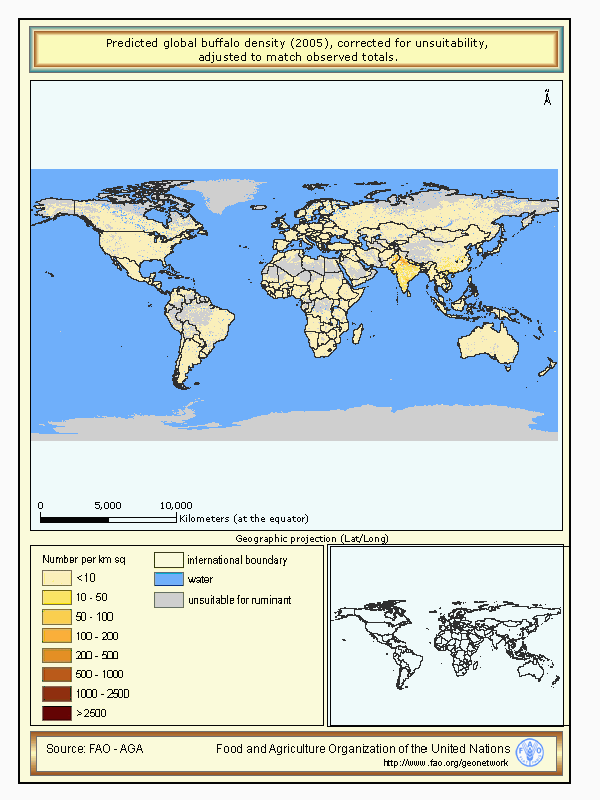
This data-set shows the most recent global model of the ducks distribution. It is the first update (version 2.01) of the recently published Gridded Livestock of the World (GLW) 2.0 (May 2014). More information and access to the data of GLW version 2.0 are in the dedicated application: http://livestock.geo-wiki.org/ The GLW 2007 remains available for download in FAO Geonetwork. However, the user is advised that a quantitative assessment of change is not possible between the GLW 2007 and the GLW 2.0 (and its updates) due to different modeling techniques, spatial resolution, predicting variables and training data. GLW 2.0 and its updates map separately the chickens and the ducks distributions. The bibliographic reference to the GLW 2.0 and its updates is: Robinson TP, Wint GRW, Conchedda G, Van Boeckel TP, Ercoli V, Palamara E, Cinardi G, D’Aietti L, Hay SI, and Gilbert M. (2014) Mapping the Global Distribution of Livestock. PLoS ONE 9(5): e96084. doi:10.1371/journal.pone.0096084
-
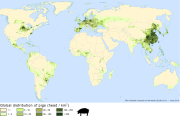
This data-set shows the most recent global model of the pigs distribution. It is the first update (version 2.01) of the recently published Gridded Livestock of the World (GLW) 2.0 (May 2014). More information and access to the data of the GLW version 2.0 are in the dedicated web-site: http://livestock.geo-wiki.org/ The GLW 2007 remains available for download in FAO Geonetwork. However, a quantitative assessment of change is not possible between the GLW 2007 and the GLW 2.0 (and its updates) due to different modeling techniques, spatial resolution, predicting variables and training data. The bibliographic reference to the GLW 2.0 and its updates is: Robinson TP, Wint GRW, Conchedda G, Van Boeckel TP, Ercoli V, Palamara E, Cinardi G, DâAietti L, Hay SI, and Gilbert M. (2014) Mapping the Global Distribution of Livestock. PLoS ONE 9(5): e96084. doi:10.1371/journal.pone.0096084 The supplementary information includes a list of the observed data used to train this version of the pigs model.
-
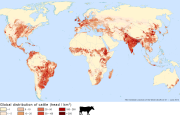
This data-set shows the most recent global model of the cattle distribution. It is the first update (version 2.01) of the recently published Gridded Livestock of the World (GLW) 2.0 (May 2014). More information and access to the data of the GLW 2.0 are in the dedicated web-site: http://livestock.geo-wiki.org/ The GLW 2007 remains available for download in FAO Geonetwork. However, a quantitative assessment of change is not possible between the GLW 2007 and the GLW 2.0 (and its updates) due to different modeling techniques, spatial resolution, predicting variables and training data. The bibliographic reference to the GLW 2.0 and its updates is: Robinson TP, Wint GRW, Conchedda G, Van Boeckel TP, Ercoli V, Palamara E, Cinardi G, DâAietti L, Hay SI, and Gilbert M. (2014) Mapping the Global Distribution of Livestock. PLoS ONE 9(5): e96084. doi:10.1371/journal.pone.0096084 The supplementary information includes a list of the observed data used to train this version of the cattle model.
-
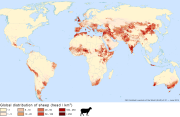
This data-set shows the most recent global model of the sheep distribution. It is the first update (version 2.01) of the recently published Gridded Livestock of the World (GLW) 2.0 (May 2014). More information and access to the data of the GLW version 2.0 are in the dedicated web-site: http://livestock.geo-wiki.org/ The GLW 2007 remains available for download in FAO Geonetwork. However, a quantitative assessment of change is not possible between the GLW 2007 and the GLW 2.0 (and its updates) due to different modeling techniques, spatial resolution, predicting variables and training data. The bibliographic reference to the GLW 2.0 and its updates is: Robinson TP, Wint GRW, Conchedda G, Van Boeckel TP, Ercoli V, Palamara E, Cinardi G, DâAietti L, Hay SI, and Gilbert M. (2014) Mapping the Global Distribution of Livestock. PLoS ONE 9(5): e96084. doi:10.1371/journal.pone.0096084 The supplementary information includes a list of the observed data used to train this version of the sheep model.
-
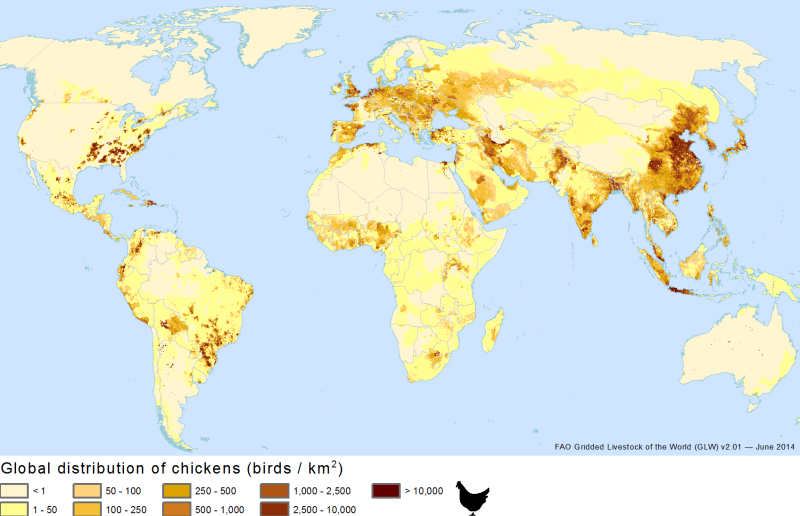
This data-set shows the most recent global model of the chickens distribution. It is the first update (version 2.01) of the recently published Gridded Livestock of the World (GLW) 2.0 (May 2014). More information and access to the data of the GLW version 2.0 are in the dedicated web-site: http://livestock.geo-wiki.org/ The GLW 2007 remains available for download in FAO Geonetwork. However, a quantitative assessment of change is not possible between the GLW 2007 and the GLW 2.0 (and its updates) due to different modeling techniques, spatial resolution, predicting variables and training data. GLW 2.0 and its updates map separately the chickens and the ducks distributions whereas GLW 2007 mapped a single poultry distribution. The bibliographic reference to the GLW 2.0 and its updates is: Robinson TP, Wint GRW, Conchedda G, Van Boeckel TP, Ercoli V, Palamara E, Cinardi G, D’Aietti L, Hay SI, and Gilbert M. (2014) Mapping the Global Distribution of Livestock. PLoS ONE 9(5): e96084. doi:10.1371/journal.pone.0096084 The supplementary information includes a list of the observed data used to train this version of the chickens model.
-
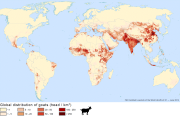
This data-set shows the most recent global model of the goats distribution. It is the first update (version 2.01) of the recently published Gridded Livestock of the World (GLW) 2.0 (May 2014). More information and access to the data of the GLW version 2.0 are in the dedicated web-site: http://livestock.geo-wiki.org/ The GLW 2007 remains available for download in FAO Geonetwork. However, a quantitative assessment of change is not possible between the GLW 2007 and the GLW 2.0 (and its updates) due to different modeling techniques, spatial resolution, predicting variables and training data. The bibliographic reference to the GLW 2.0 and its updates is: Robinson TP, Wint GRW, Conchedda G, Van Boeckel TP, Ercoli V, Palamara E, Cinardi G, DâAietti L, Hay SI, and Gilbert M. (2014) Mapping the Global Distribution of Livestock. PLoS ONE 9(5): e96084. doi:10.1371/journal.pone.0096084 The supplementary information includes a list of the observed data used to train this version of the goats model.
 FAO Map Catalog
FAO Map Catalog